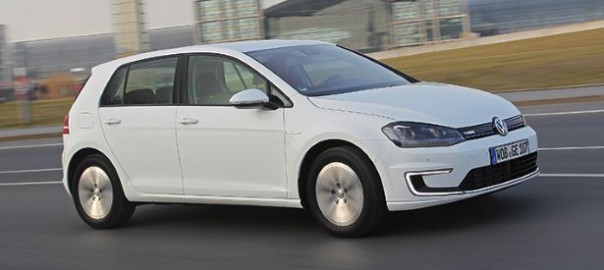We take a spin in VW’s all-electric hatch. Is this, finally, an EV that makes sense for normal people?
What is it?
It’s the first-ever Golf to entirely do away with that old-school notion of an internal combustion engine. The e-Golf is instead propelled solely by an electric motor, fed by a battery pack, sending 113bhp to the front wheels. It’ll get from zero to 37mph in 4.2 seconds, to 62mph around six seconds later, and top out at 87mph. Prices start at £25,845 (including government EV subsidy) when it lands in the UK this summer.
It doesn’t sound very fast.
Honestly, in real-world driving, the e-Golf feels not only faster than those figures would suggest, but fast full-stop. There’s a fabulous slug of torque available from standstill – 199lb ft, no less – which gives the e-Golf a proper kick away from the lights. There’s so much twist on tap, in fact, that it’ll even spin its wheels if you get too lairy on the throttle.
Speaking of throttles, VW says its electric motor will turn your twitch-of-right-foot into torque at the wheels five times faster than a conventional petrol engine. Which means this thing has seriously pokey responses. Spot a gap, prod accelerator, be there. It’s not quite driving as we know it, but it’s rather lovely all the same.
Does it have that weird regen braking?
Yes, but you can alter the aggressiveness of the energy capture system, from almost non-existent to hauling you to a pretty rapid standstill as soon you lift off the throttle. The latter mode requires something of a recalibration of your brain and right foot, but once you’ve acclimatised it makes a lot of sense around town, and means you virtually never have to actually hit the brake pedal.
But if you don’t like it, you can dial out the effect of the regenerative braking, at which point the e-Golf feels like, well… like every other Golf: refined, solid, nice to steer, with all the VW nav/music/interior goodies we’ve come to expect. And, of course, it’s incredibly quiet, the only peep from the drivetrain a faint sci-fi whine at motorway speeds.
How far will it go on a charge?
VW quotes a range of 118 miles – claiming that its Golf is around 30 per cent more energy efficient than competitors such as the Nissan Leaf – but as ever with EVs, it depends how you drive.
In a mix of passably sensible urban and dual-carriageway stuff, we got just under 100 miles from a charge. Crank up the air con and attempt a triple-digit autobahn charge and you can half that figure. But that’s rather what the e-Golf does, in a gentle, non-sanctimonious way: makes you question exactly how much energy you really need to munch through.
Do you actually need full-blast air con (minus 15 miles from your range), or could you just open a window? Do you need the full 113bhp on tap when you’re crawling through traffic, or could you drop your Golf into ‘Eco’ or ‘Eco+’ mode, dialling down the power and increasing range yet further? It’s not how TG has traditionally sought its thrills, but it’s strangely addictive nonetheless.
On the subject of range, tell me about the battery.
It’s a posh lithium-ion job, with a 24.2kW capacity and a weight 318kg. That mass has no ill effect on handling, however, as the battery pack is tucked down between the axles, effectively under the passengers’ feet.
Doesn’t that mean there’s nowhere to store your feet?
No, legroom is identical to that of the normal-engined Golfs. Space for a battery pack was engineered into the MQB architecture from the start, so there’s no compromise to package the e-Golf’s electric gubbins. As you’d expect from VW, this is no bodge-job: every one of the Golf’s components has been optimised to consume as little energy as possible. It’s slippier, too, than the standard car, with a drag coefficient of 0.28 against the diesel Golf’s 0.31.
So should I buy one?
As ever with EVs, it depends what you need from your car. A realistic range of 100-odd miles is far more than enough for most day-to-day commuting needs, and equates to some dirt cheap motoring. VW reckons that, with the right energy tariff, you’ll pay around 5p per mile for your electricity: if TG’s maths is correct, a petrol car averaging 30mpg will cost you around 15p per mile at current UK fuel prices.
But if you’re regularly schlepping from Birmingham to Cornwall, the e-Golf won’t work for you: though it can be 80 per cent fast-charged in just 30 minutes, you’ll need 13 hours to brim the battery at home. And, of course, that requires a driveway, or at least a parking space with convenient power socket: your local constabulary might not be too happy about you dangling a flex from your third-storey flat to the street below.
But if the glove fits, by all means wear it. The e-Golf is an EV that works not just for urban statement-makers, but for most of us, most of the time. With the possible exception of the Tesla Model S – which is aimed at a very different end of the market – it’s the most convincing electric car ever made.
Source: Top Gear (March 2014)
